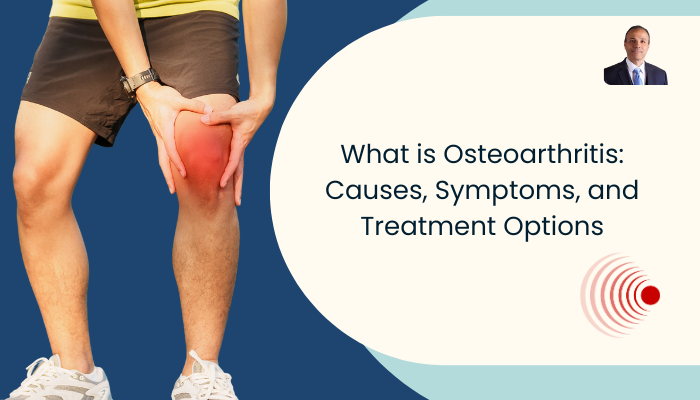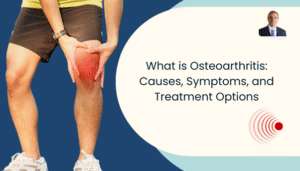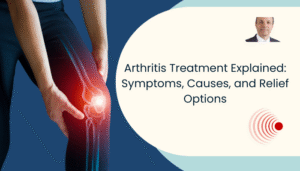What is Osteoarthritis: Causes, Symptoms, and Treatment Options

As we navigate life’s journey, the wear and tear on our bodies can sometimes manifest as discomfort and pain, particularly in our joints.
One of the most common culprits behind this is osteoarthritis. Dr Mohamed El Toukhy is dedicated to helping you understand and manage conditions like osteoarthritis, empowering you to live a more comfortable and active life.
This guide will cover osteoarthritis in detail, including its causes, key symptoms, and the various treatment approaches available.
We’ll examine common types of osteoarthritis, such as knee and cervical osteoarthritis, compare them briefly with rheumatoid arthritis, and highlight medical and non-medical approaches, such as medications, exercises, and lifestyle strategies, to help manage pain and improve quality of life.
What is Osteoarthritis? The breakdown of joint health
Cartilage protects the ends of bones and aids in smooth joint movement. Its deterioration leads to direct bone contact, often causing pain, limited motion, and joint swelling.
Unlike inflammatory arthritis, such as rheumatoid arthritis, osteoarthritis is primarily considered a “wear and tear” condition.
However, the process is more complex than just simple wearing out; it involves a cascade of biological events that lead to cartilage degradation, bone changes, inflammation, and loss of function.
Unravelling the causes: What leads to osteoarthritis?
While the exact cause of osteoarthritis isn’t always clear, several factors are known to increase the risk of developing it. These include:
- Age: Osteoarthritis increases with age. Over time, the cartilage in joints can naturally wear down.
- Genetics: A family history of osteoarthritis can increase a person’s likelihood of developing the disease.
- Obesity: Excess weight stresses weight-bearing joints like the knees and hips, accelerating cartilage breakdown.
- Joint injury: Damage from previous accidents or sports injuries can make a joint more susceptible to osteoarthritis in the future.
- Repetitive stress: Repetitive motions from specific jobs or physical tasks may contribute to wear and tear on the joints, leading to osteoarthritis over time.
- Bone deformities: Some individuals are born with abnormal joint structures, increasing their risk of developing osteoarthritis.
- Gender: Osteoarthritis is more common in women than in men, though the exact reasons remain unclear.
Recognising the signs: Osteoarthritis symptoms
Symptoms of osteoarthritis are not the same for everyone and can vary in severity. Common symptoms of osteoarthritis include:
- Pain: The joint pain becomes more intense with movement and eases with rest, though it can continue even at rest as the condition progresses.
- Stiffness: Joint stiffness in the morning or after periods of inactivity, usually lasting less than 30 minutes.
- Tenderness: The joint may be painful or sensitive to pressure.
- Loss of flexibility: Difficulty moving the joint through its full range of motion.
- Grating sensation: A feeling of grinding or clicking within the joint during movement.
- Bone spurs: New bone formations may appear around the impacted joint.
- Swelling: Inflammation around the joint.
Focus on specific areas: Knee osteoarthritis and cervical osteoarthritis
Osteoarthritis can impact joints throughout the body, but it is most commonly found in the knee, hip, and spine, which bear the body’s weight.
Knee osteoarthritis: Knee osteoarthritis is a frequent cause of knee pain, particularly in older adults.
In more severe cases, knee osteoarthritis symptoms may involve pain during activities like walking, climbing stairs, or even resting. You might also experience stiffness, swelling, and a grinding sensation in the knee.
Cervical osteoarthritis: Cervical osteoarthritis, also known as cervical spondylosis, affects the joints in the neck. Symptoms can include neck pain, stiffness, headaches originating in the neck, and sometimes pain radiating into the shoulders or arms.
Osteoarthritis vs rheumatoid arthritis: Understanding the difference
It’s essential to distinguish osteoarthritis from rheumatoid arthritis. While both are forms of arthritis, they are fundamentally different:
Osteoarthritis: As discussed, this is primarily a degenerative condition caused by the breakdown of cartilage.
Rheumatoid arthritis: In this condition, the body’s immune system mistakenly damages the joint lining, triggering inflammation. The disease often targets several joints symmetrically, causing notable inflammation, morning stiffness that persists for more than 30 minutes, and systemic issues like fatigue.
Osteoarthritis, in contrast, typically affects individual joints and is less associated with widespread inflammation and systemic symptoms.
The path to relief: Osteoarthritis treatments
While there isn’t a cure for osteoarthritis, many effective treatments are available to manage pain, improve function, and slow disease progression. These can be generally divided into non-pharmacological and pharmacological methods.
1- Non-pharmacological osteoarthritis knee treatments
These treatments focus on lifestyle modifications and therapies:
- Exercise: Consistent, low-impact exercises like walking, swimming, and cycling can help reinforce the muscles around the affected joint, provide support, and increase flexibility. Specific knee osteoarthritis exercises are often recommended for knee osteoarthritis.
- Physical and occupational therapy: Therapists can show you exercises that enhance your range of motion, strength, and stability, along with techniques for carrying out everyday activities with reduced pain.
- Weight management: Reducing body weight can significantly lessen the strain on joints that bear weight, like the knees and hips.
- Assistive devices: Canes, walkers, or braces can help relieve pressure on affected joints and improve movement.
- Heat and cold therapy: Heat can relieve joint stiffness and muscle tension, while cold can help minimise swelling and discomfort.
2- Pharmacological osteoarthritis treatments (Osteoarthritis medicine)
Various medications can help manage osteoarthritis pain:
- Over-the-counter pain relievers: Acetaminophen and NSAIDs, including ibuprofen and naproxen, are commonly used to ease pain and reduce inflammation.
- Prescription NSAIDs: Stronger NSAIDs are available with a prescription.
- Corticosteroid injections: Corticosteroid injections into the affected joint can offer short-term relief from both pain and inflammation.
- Hyaluronic acid injections: These injections aim to lubricate the joint and may provide some pain relief, particularly in knee osteoarthritis.
- Topical medications: To reduce pain, creams, gels, and patches containing NSAIDs or capsaicin can be applied to the skin above the affected joint.
- Duloxetine: This antidepressant can also help with chronic pain, including osteoarthritis pain.
Surgical options for osteoarthritis
Surgery may be recommended for joints like the knee and hip when conservative approaches no longer offer adequate relief.
Joint replacement: This procedure involves removing the damaged joint and inserting an artificial one. Hip and knee replacements are standard and usually result in substantial pain reduction and better joint function.
Osteotomy: This procedure involves cutting and reshaping a bone to relieve pressure on the damaged part of the joint. It’s sometimes used in younger patients with knee osteoarthritis.
How to cure knee osteoarthritis?
It’s important to understand that while symptoms can be effectively managed and the progression potentially slowed, osteoarthritis is currently not curable. Treatment is centred on easing pain, increasing functional ability, and boosting quality of life.
FAQs
OA, or osteoarthritis, is a degenerative disease that causes cartilage in the joints to wear away, resulting in stiffness and pain.
Common osteoarthritis symptoms include joint pain, stiffness, tenderness, and loss of flexibility.
Osteoarthritis is primarily “wear and tear,” while rheumatoid arthritis is an autoimmune inflammatory disease.
Common osteoarthritis treatments include exercise, physical therapy, pain relievers (osteoarthritis medicine), and sometimes surgery.
Specific exercises for knee osteoarthritis are intended to build muscle strength and improve knee flexibility.
Yes, cervical osteoarthritis, affecting the neck joints, is a common cause of neck pain.
While symptoms of knee osteoarthritis can be effectively managed, there isn’t a known “cure.” Instead, the focus is on treating osteoarthritis to relieve pain.
The general treatment for osteoarthritis aims to reduce pain and improve joint function through various methods.
Your journey to managing osteoarthritis pain
Living with osteoarthritis pain can be challenging, but it doesn’t have to define your life. Dr Mohamed El Toukhy believes in a holistic approach to managing this condition, combining various osteoarthritis treatments tailored to your needs.
He is here to guide you through the options, from lifestyle modifications and exercises to medications and advanced therapies. Book an appointment now.
Related Post

What are trigger point injections?
What are trigger point injections? Sometimes, muscle pain can be

What is Osteoarthritis: Causes, Symptoms, and Treatment Options
What is Osteoarthritis: Causes, Symptoms, and Treatment Options As we

Arthritis Treatment Explained: Symptoms, Causes, and Relief Options
Arthritis Treatment Explained: Symptoms, Causes, and Relief Options Break Free

